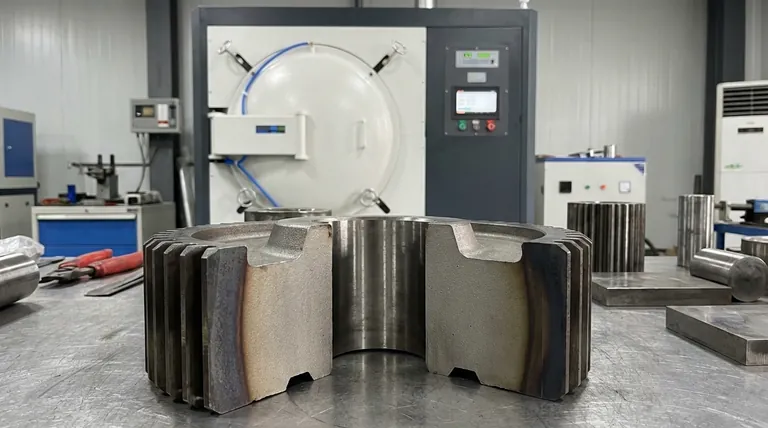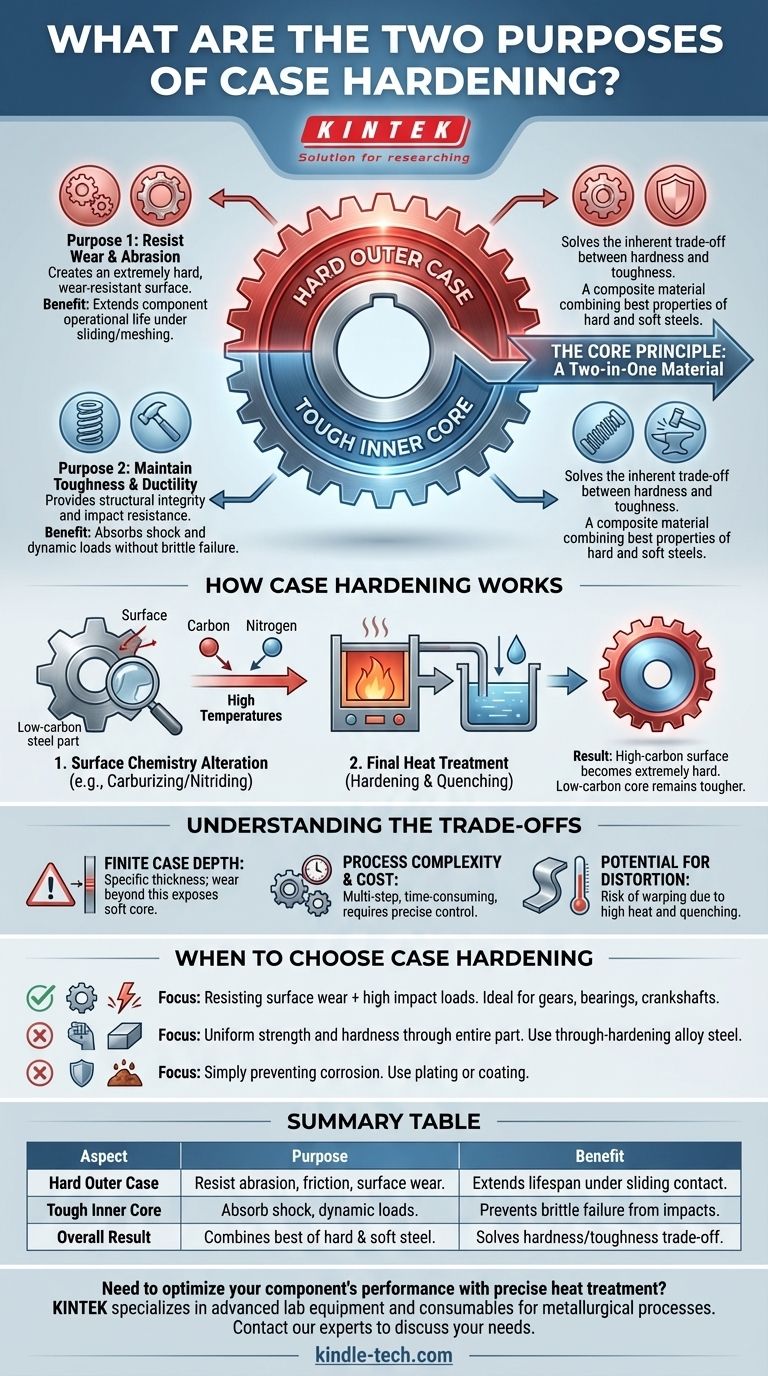The two primary purposes of case hardening are to create an extremely hard, wear-resistant outer surface on a metal component while simultaneously maintaining a softer, tougher, and more ductile inner core. This process effectively creates a composite material, combining the most desirable properties of both hard and soft steels into a single part.
The core problem case hardening solves is the inherent trade-off between hardness and toughness in metals. It allows engineers to design a component that won't wear down from friction but also won't shatter from a sudden impact.

The Core Principle: A Two-in-One Material
Case hardening is a method for selectively engineering the properties of a metal part. It's based on the understanding that for many applications, the stresses a component faces are not uniform throughout its cross-section.
The Hard Outer "Case"
The primary goal of the surface layer, or "case," is to resist wear. This is crucial for parts that rub, slide, or mesh against other components.
This hardened case provides exceptional resistance to abrasion, friction, and surface indentation. By making the surface significantly harder, you dramatically extend the operational life of the component.
The Tough Inner "Core"
Beneath the hard case lies the core, which is deliberately left in a softer, more ductile state. Its purpose is to provide structural integrity and impact resistance.
This toughness allows the component to absorb shock and dynamic loads without cracking. A part that was uniformly hard all the way through would be brittle and could catastrophically fail under a sudden jolt.
Why Not Through-Harden?
Through-hardening, or hardening a part uniformly, creates a material that is strong but often brittle.
Think of it like glass: it's very hard and scratch-resistant, but it shatters easily when dropped. For components like gears or camshafts, which face both constant friction and periodic impacts, this brittleness is a critical point of failure.
How Case Hardening Works
The process achieves its dual nature by altering the chemistry of the steel's surface before a final heat treatment.
Changing the Surface Chemistry
The most common methods involve diffusing elements into the surface of a low-carbon steel part at high temperatures.
In carburizing, carbon is infused into the surface. In nitriding, nitrogen is used. This creates a surface layer with a high concentration of these elements, giving it the potential to become much harder than the low-carbon core.
The Final Heat Treatment
After the surface chemistry is altered, the part undergoes a heat treatment cycle (hardening and quenching).
Because of its new high-carbon or high-nitrogen composition, the surface layer becomes extremely hard upon quenching. The low-carbon core does not react as dramatically to the quench, so it remains in a softer, tougher state.
Understanding the Trade-offs
While incredibly useful, case hardening is not a universal solution. It's an engineered process with specific limitations to consider.
Finite Case Depth
The hardened layer has a specific thickness, known as the case depth. This is typically a small fraction of the component's total thickness. If wear exceeds this depth, the part will fail rapidly as the soft core becomes exposed.
Process Complexity and Cost
Case hardening is a multi-step, time-consuming process that requires precise control over temperature and atmospheric conditions. This makes it more complex and costly than simple through-hardening.
Potential for Distortion
Any time a part is subjected to high heat and rapid cooling (quenching), there is a risk of warping or distortion. This must be anticipated and managed, sometimes requiring finish grinding after treatment.
When to Choose Case Hardening
Applying this process correctly depends entirely on the mechanical demands of the component.
- If your primary focus is resisting surface wear while withstanding high impact loads: Case hardening is the ideal solution, making it standard for gears, bearings, and crankshafts.
- If your primary focus is uniform strength and hardness through the entire part: A through-hardening alloy steel is the more direct and appropriate choice.
- If your primary focus is simply preventing corrosion: Other surface treatments like plating or coating may be more cost-effective and suitable than case hardening.
Ultimately, case hardening is the definitive engineering solution for creating a single component that can both endure constant friction and survive sudden impact.
Summary Table:
| Aspect | Purpose | Benefit |
|---|---|---|
| Hard Outer Case | Resist abrasion, friction, and surface wear. | Extends component lifespan under sliding or meshing contact. |
| Tough Inner Core | Absorb shock and dynamic loads without cracking. | Prevents catastrophic brittle failure from sudden impacts. |
| Overall Result | Combines the best properties of hard and soft steel in one part. | Solves the inherent trade-off between hardness and toughness for components like gears and bearings. |
Need to optimize your component's performance with precise heat treatment? KINTEK specializes in providing advanced lab equipment and consumables for metallurgical processes like case hardening. Our solutions help you achieve the perfect balance of surface hardness and core toughness for gears, bearings, and other critical parts. Contact our experts today to discuss how we can support your laboratory's material testing and development needs!
Visual Guide

Related Products
- Vacuum Heat Treat Furnace with Ceramic Fiber Liner
- Vacuum Heat Treat Sintering Brazing Furnace
- Molybdenum Vacuum Heat Treat Furnace
- 2200 ℃ Tungsten Vacuum Heat Treat and Sintering Furnace
- Vacuum Heat Treat and Molybdenum Wire Sintering Furnace for Vacuum Sintering
People Also Ask
- What is the maximum temperature in a vacuum furnace? It Depends on Your Materials and Process Needs
- What is the standard thickness of plating? Optimize Durability, Corrosion & Cost
- Can I vacuum the inside of my furnace? A Guide to Safe DIY Cleaning vs. Professional Service
- What is a vacuum furnace used for? Unlock Purity in High-Temperature Processing
- What is the leak rate for a vacuum furnace? Ensure Process Purity and Repeatability



















